In Portugal, bread is a constant presence at a table. We have it for breakfast, lunch, snack and dinner. The tradition of eating bread has been lost in time.
Portugal offers a variety of delicious Portuguese breads with different ingredients. Each of them has a unique color, taste and texture. Some are traditional from a particular region, city or village.
In this article, I´ll try to list the different types of Portuguese bread from the most traditional to the more common found in any bakery or supermarket.
Traditional bread
Bola de Carne à Lavrador e Bola de Bacalhau
Bread with a rectangular shape. Made from wheat flour and sourdough and filled with pork smoked meat or codfish. Eaten as starter or for snack. Traditional from Marco de Canaveses municipality, located in the North of Portugal. Pronunciation: /bôla/

Bola de Centeio de Barroso
Made from rye flour and sourdough filled with pork meat (entremeada), smoked sausage (chouriça de carne) and onion. Eaten mainly for snack. Typical from Montalegre and Boticas municipalities that make the Barroso region. Pronunciation: /bôla/.

Bola de Lamego
Made from wheat flour and filled with meat, codfish or sardine. Eaten for a snack or starter, particularly, in dinner parties as the São João night (23th June). Found in the North, particularly in Lamego municipality. Pronunciation: /bôla/

Bolo do Caco
Flat and round bread made from wheat flour from a dough less ‘risen’ than normal. Cooked in a clay pan under hot ash or fire. Eaten alone hot with garlic butter or as a side of some dishes. Traditional from the Madeira Island. Pronunciation: /bôlu/.

Bolo Lêvedo
Similar to Bolo do Caco but with sugar. Eaten at any meal with butter, ham, cheese or jam. Traditional from the village of Furnas in Azores island. Pronunciation: /bôlu/

Broa
Round shaped bread made from corn and rye flour. The proportions depend on where it´s made, giving it a different color. Compared with normal bread, it´s harder and thicker. Eaten normally at lunch as a starter. Typical from the North Region.

Broa de Avintes
Made from white corn and rye flour of dark color with a small or no crust. Eaten as side or together with wine, sausages, caldo verde (a soup) and sardines. Originally from Avintes, a parish of the city of Vila Nova de Gaia.

Broa de Milho da Beira Alta
Round shaped bread made from corn flour with a crispy crust. Typical from Beira Alta region in the center of country.

Fogaça da Feira
Sweet bread with a mild lemon and cinnamon flavor and aroma. It has a conic shape with four spikes resembling the Santa Maria da Feira Castle from where it is traditional. Every year a 5 centuries old celebration is held in honor of the Fogaceiras (women that carried the bread) – Festa das Fogaceiras.

Folar de Trás-os-Montes
Rectangular and round shaped bread made from flour, eggs and sourdough. Filled with smoked pork meat (presunto, salpicão e toucinho). Typical from the Trás-os-Montes region and made only during the Easter period. Also called Folar de Valpaços or Bola de Carne Transmontana.

Padas de Vale de Ílhavo
Small bread made from wheat flour by joining two smaller bread. Made all year long. On Sundays it´s traditional not to bake bread. Original from Ilhavo valley in the center of Portugal.

Pão com Chouriço
Bread made with wheat flour filled with smoked meat – chouriço or sometimes chourição. Originally from Marco de Canaveses, in North of Portugal. It can be easily found in market or fairs.

Pão de Alfarroba
Round bread made with 85% of wheat flour and 15% of carob flour. Generally it served as starter together with honey and cottage cheese. Typical from Algarve region.

Pão de Centeio da Guarda
Round bread made from rye flour and baker’s yeast. Typical from Guarda, in the center of Portugal.
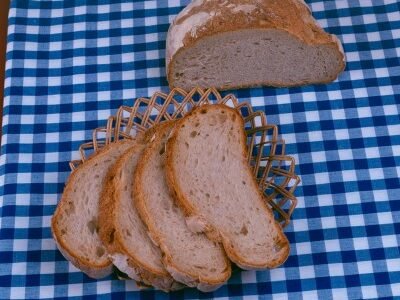
Pão de Centeio de Barroso
Round bread made from rye flour. Typical from the region of Barroso, in the north of Portugal.
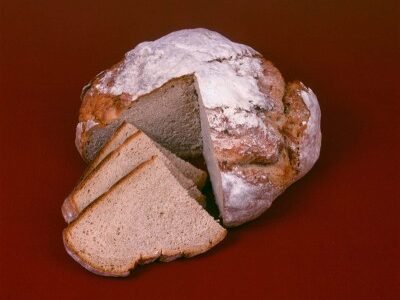
Pão de Centeio de Castro Laboreiro
Round bread made from rye flour and wheat or corn flour. Eaten with other meals and it can be used to make a kind of soup. Typical from the village of Castro Laboreiro, in the north of Portugal.

Pão de Centeio do Sabugeiro
Round bread made from rye flour and wheat flour. Traditional from the Sabugeiro region, the highest village in the country.

Pão de Mafra
Hollow bread that can be sold in different shapes – round or long. Typical from the Mafra region nearby Lisbon.

Pão de Trigo do Alentejo
Bread made from wheat flour with a curious shape – half of the bread is higher and the other one. Eaten alone or used to make traditional Alentejo dishes like açorda alentejana, migas, sopa de cachola ou sopa de cação.

Carcaça, Papo-seco, Rosca, Viana, Bijou ou Molete
These are made with the same type of flour but they have different shapes. Carcaça, papo-seco and rosca are more alongated .Bijou/molete and viana are rounded. In Lisbon region carcaça, rosca and viana are more traditional. Bijou ou molete is found in Porto region, while papo-seco in Ribatejo, Alentejo and the west region. Eaten for breakfast or light meals, it has became the “bread of the people”.

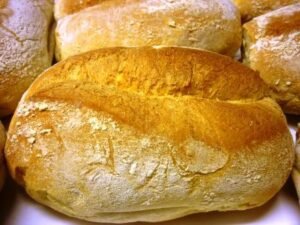


Regueifa
Rounded or long bread with a crispy crust. Depending on the shape, it can be called in different ways: regueifa redonda, regueifa aberta, regueifa trançada or roca cortada. Typical in the north of the Portugal, it´s bought and eaten on Sundays.
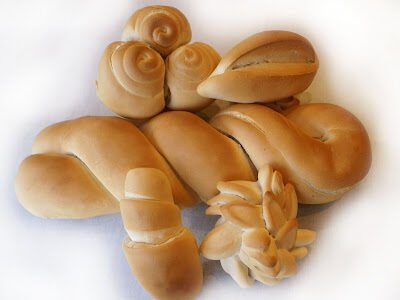
Pão da Mealhada
Small bread made from wheat flour. In the crust, one can see four spikes made the help of a scissor. It´s the typical bread from the city of Mealhada.
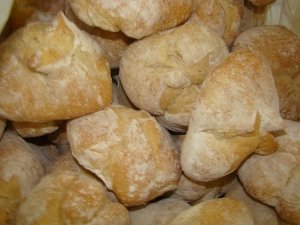
Most Popular Bread
Pão de Rio Maior
Rounded bread made from wheat flour. It was the first certified bread when was created in 1990.

Pão de leite
Rounded shape bread made with wheat flour with egg and milk.

Pão de forma
Loaf of bread or sliced bread. Normally used to do torrada and tosta.

Pão de água
In this bread there’s more water than usual which makes it more hollow inside.

Chapata
Flat and cripsy bread made with wheat and rye flour. Original from Italy.

Bola de lenha
Rounded bread made from wheat flour.

Bola de centeio
Rounded bread made from wheat and rye flour.

Baguete
French Baguette made typically with wheat flour.

Cacetinho
Elongated bread made with wheat flour.

Bola de mistura
Rounded bread with wheat and rye flour.

Pão integral
Wholegrain bread.

Pão da Avó
Rounded bread made with wheat and rye flour.

Bola Tigre
Rounded bread made with wheat flour with a coat of rice flour.

Pão de milho e girassol
Rounded bread with wheat flour. A powder of sunflower seeds and corn is used for decoration.



